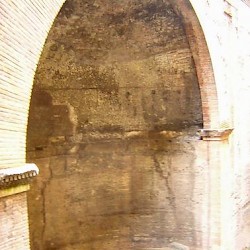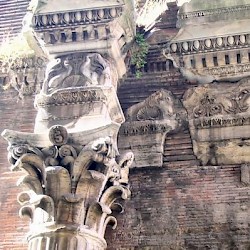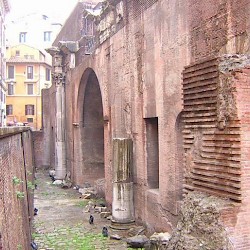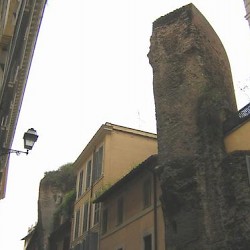Rome, Baths of Agrippa
Q518832Baths of Agrippa: bathhouse near the Pantheon, built by Agrippa, the right-hand man of the emperor Augustus. The Basilica of Neptune was part of it and is quite well-preserved.

Marcus Vipsanius Agrippa (64/63-12 BCE) was a close friend of the emperor Augustus, who ruled Rome from 27 BCE to 14 CE. In 33, the two men started a large building project to improve the quality of life in the city of Rome. Probably financed from the spoils of the Dalmatian War (35-34), it was supervised by Agrippa, who occupied the office of aedile. The project received a new boost when Agrippa occupied the consulship in 27. Most buildings were completed by 25. One of the main buildings was the Pantheon, which is not identical to the current building with that name, because this is a later building phase from the age of the emperor Hadrian (117-138).
Basilica of Neptune
South of to the Pantheon was a rectangular hall that measured about 46 x 19 meters, called the "Basilica of Neptune", after the god of the sea. His statue must have stood in the central apse. The brickwork proves that in its present form, it dates back to the time of Hadrian, but its depth - 2½ meters below street level - proves that the structure itself goes back to the age of Augustus and Agrippa.
Agrippa had good reasons to be grateful to this deity, because he had risen to fame and power after he had won several naval engagements. In the battles of Mylae and Naulochus in 36, he had defeated Sextus Pompeius the last republican resistance against monarchy; in the naval battle of Actium, in 31, he had overcome Mark Antony and Queen Cleopatra VII Philopator of Egypt, thus paving the way for the unchallenged monarchy for his friend Augustus.

The decoration of the basilica contains all kinds of sea motifs. You can see shells, leaping delphins, and Neptune's tridents. There are also acanthus leaves and palmettes, which are traditional motifs. Although substantial parts are preserved, it is not known for what purpose the Basilica of Neptune was built. The original building was destroyed by a fire in 80.
Baths of Agrippa
The emperor Hadrian incorporated the Basilica of Neptune into the Baths of Agrippa or Thermae Agrippae, which are now almost completely invisible, except for a curving wall of brick that once supported a dome with a diameter of 23 meters. It is in the Via dell' Arco della Ciambellao.
Although built by Agrippa, this was one of the first "imperial" bathhouses, because Augustus of course paid for its construction. Measuring about 90 x 120 meters, the baths were finished in 19 BCE.
It is known that there was a large open air swimming pool south of the Baths of Agrippa. The Roman author Pliny the Elder tells that among the many statues that decorated the complex was the famous Apoxyomenos of Lysippus:
It was dedicated by Marcus Agrippa in front of his Baths. [Emperor] Tiberius also much admired this statue [...] and removed the Apoxyomenos to his bedroom, substituting a copy. But the people of Rome were so indignant about this that they staged a protest in the theater, shouting "Bring back the Apoxyomenos!" And so despite his passion for it, Tiberius was obliged to replace the original statue.note
The Baths of Agrippa were destroyed by fire in 80, restored by Hadrian, and restored a second time in 344-345 by Emperor Constans.
 Rome, Baths of Agrippa, Basilica of Neptune, Central apse |
 Rome, Baths of Agrippa, Basilica of Neptune, Decoration |
 Rome, Basilica of Neptune |
 Rome, Baths of Agrippa |